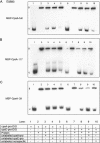Functional analysis of the CpsA protein of Streptococcus agalactiae
- PMID: 22287515
- PMCID: PMC3302465
- DOI: 10.1128/JB.06373-11
Functional analysis of the CpsA protein of Streptococcus agalactiae
Abstract
Streptococcal pathogens, such as the group B streptococcus (GBS) Streptococcus agalactiae, are an important cause of systemic disease, which is facilitated in part by the presence of a polysaccharide capsule. The CpsA protein is a putative transcriptional regulator of the capsule locus, but its exact contribution to regulation is unknown. To address the role of CpsA in regulation, full-length GBS CpsA and two truncated forms of the protein were purified and analyzed for DNA-binding ability. Assays demonstrated that CpsA is able to bind specifically to two putative promoters within the capsule operon with similar affinity, and full-length protein is required for specificity. Functional characterization of CpsA confirmed that the ΔcpsA strain produced less capsule than did the wild type and demonstrated that the production of full-length CpsA or the DNA-binding region of CpsA resulted in increased capsule levels. In contrast, the production of a truncated form of CpsA lacking the extracellular LytR domain (CpsA-245) in the wild-type background resulted in a dominant-negative decrease in capsule production. GBS expressing CpsA-245, but not the ΔcpsA strain, was attenuated in human whole blood. However, the ΔcpsA strain showed significant attenuation in a zebrafish infection model. Furthermore, chain length was observed to be variable in a CpsA-dependent manner, but could be restored to wild-type levels when grown with lysozyme. Taken together, these results suggest that CpsA is a modular protein influencing multiple regulatory functions that may include not only capsule synthesis but also cell wall associated factors.
Figures









Similar articles
-
Modification of the CpsA protein reveals a role in alteration of the Streptococcus agalactiae cell envelope.Infect Immun. 2015 Apr;83(4):1497-506. doi: 10.1128/IAI.02656-14. Epub 2015 Feb 2. Infect Immun. 2015. PMID: 25644003 Free PMC article.
-
Membrane topology and DNA-binding ability of the Streptococcal CpsA protein.J Bacteriol. 2011 Jan;193(2):411-20. doi: 10.1128/JB.01098-10. Epub 2010 Nov 19. J Bacteriol. 2011. PMID: 21097630 Free PMC article.
-
Streptococcus agalactiae capsule polymer length and attachment is determined by the proteins CpsABCD.J Biol Chem. 2015 Apr 10;290(15):9521-32. doi: 10.1074/jbc.M114.631499. Epub 2015 Feb 9. J Biol Chem. 2015. PMID: 25666613 Free PMC article.
-
Surface proteins of Streptococcus agalactiae and related proteins in other bacterial pathogens.Clin Microbiol Rev. 2005 Jan;18(1):102-27. doi: 10.1128/CMR.18.1.102-127.2005. Clin Microbiol Rev. 2005. PMID: 15653821 Free PMC article. Review.
-
Group B streptococcal haemolysin and pigment, a tale of twins.FEMS Microbiol Rev. 2014 Sep;38(5):932-46. doi: 10.1111/1574-6976.12071. Epub 2014 Apr 4. FEMS Microbiol Rev. 2014. PMID: 24617549 Free PMC article. Review.
Cited by
-
Psr is involved in regulation of glucan production, and double deficiency of BrpA and Psr is lethal in Streptococcus mutans.Microbiology (Reading). 2013 Mar;159(Pt 3):493-506. doi: 10.1099/mic.0.063032-0. Epub 2013 Jan 3. Microbiology (Reading). 2013. PMID: 23288544 Free PMC article.
-
Molecular Characterization of Streptococcus agalactiae Causing Community- and Hospital-Acquired Infections in Shanghai, China.Front Microbiol. 2016 Aug 30;7:1308. doi: 10.3389/fmicb.2016.01308. eCollection 2016. Front Microbiol. 2016. PMID: 27625635 Free PMC article.
-
Modification of the CpsA protein reveals a role in alteration of the Streptococcus agalactiae cell envelope.Infect Immun. 2015 Apr;83(4):1497-506. doi: 10.1128/IAI.02656-14. Epub 2015 Feb 2. Infect Immun. 2015. PMID: 25644003 Free PMC article.
-
The capsular polysaccharide of Staphylococcus aureus is attached to peptidoglycan by the LytR-CpsA-Psr (LCP) family of enzymes.J Biol Chem. 2014 May 30;289(22):15680-90. doi: 10.1074/jbc.M114.567669. Epub 2014 Apr 21. J Biol Chem. 2014. PMID: 24753256 Free PMC article.
-
Zebrafish as a model for zoonotic aquatic pathogens.Dev Comp Immunol. 2014 Sep;46(1):96-107. doi: 10.1016/j.dci.2014.02.014. Epub 2014 Mar 6. Dev Comp Immunol. 2014. PMID: 24607289 Free PMC article. Review.
References
-
- Busch SJ, Sassone-Corsi P. 1990. Dimers, leucine zippers and DNA-binding domains. Trends Genet. 6: 36–40 - PubMed
Publication types
MeSH terms
Substances
LinkOut - more resources
Full Text Sources
Other Literature Sources
Medical

